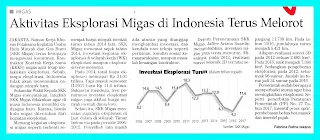Saka Energi Indonesia is interested in auction two blocks of oil and gas, namely Block Pekawai and West Yamdena Block. President Director of PT Saka Energi Indonesia Tumbur Parlindungan awaits the auction of new blocs and government bids related to the block that will expire his contract. According to him, there are two areas of interest in the auction of the oil and gas block because it has conducted a study on the two blocks, namely Pekawai Block and West Yamdena-Papua Block.
Bidders who have conducted a joint study and following direct offers are more likely to get an offer. As is known, currently the government opens opportunities for investors to choose new oil and gas blocks that will be managed with a gross split contract.
This year, the government offers 15 working areas consisting of 10 conventional oil and gas blocks and five non-conventional oil and gas blocks by the end of November 2017. Meanwhile, seven conventional oil and gas blocks are offered through direct offerings namely Andaman I, Offshore Aceh; Andaman II, Offshore Aceh; South Tuna, Offshore Natuna; Merak Lampung, Offshore and Mainland Banten-Lampung; Pekawai, Offshore East Kalimantan; West Yamdena, Offshore and Mainland Maluku; and Kasuri III, West Papua Mainland.
Oil and Gas Working Area
Meanwhile, two conventional oil and gas blocks are offered through regular auctions namely, Block Tongkol, Offshore Natuna; East Tanimbar, Offshore Maluku and Mamberamo, Mainland and Offshore Papua. For non-conventional oil and gas blocks offered through direct offer of MNK Jambi I, Onshore Jambi (Shale Hydrocarbon); MNK Jambi II, Onshore Jambi & South Sumatra (Shale Hydrocarbon); GMB West Air Komering, Onshore South Sumatra (Coal Bed Methane / CBM) Later, non-conventional oil and gas blocks offered through regular auctions include GMB Raja, Onshore South Sumatra (CBM) and GMB Bungamas, Onshore South Sumatra (CBM).
Map of US Property Other Country
Saka has conducted joint study since mid 2016. For Pekawai Block, it has a total area of 8,157.15 square kilometers (km2) covering land area and offshore of East Kalimantan. Potential reserves in Block Pekawai amount 500 million barrels of oil equivalent (MMboe).
Meanwhile, the West Yamdena Block has an area of 8,209.96 km covering land and offshore areas of Maluku. The minimum commitment that must be offered by investors is Geology & Geophysics study, 2D seismic survey covering 1,000 km.
2D & 3D seismic survey
From the data of the Ministry of Energy and Mineral Resources, there are 19 documents that have been accessed related to 10 areas of conventional oil and gas work. For direct offers, there are seven oil and gas blocks that have been accessed, namely Andaman I, South Tuna, Merak Lampung, West Yamdena and Kasuri III with each accessory, Pekawai two users and Andaman II six accessors.
On the other hand, for regular auctions, there are six accesses with one accessing block, one Mamberamo Block and East Tanimbar Block with three users. In addition to the new block, Saka also eyeing the block runs out of contract. According to Tumbur, if there is still a block that will exhaust the remaining contract, it would manage the work area on its new contract.
IN INDONESIA
Saka Energi Incar Dua Blok Migas
Saka Energi Indonesia meminati lelang dua blok migas, yakni Blok Pekawai dan Blok West Yamdena. Presiden Direktur PT Saka Energi Indonesia Tumbur Parlindungan menanti lelang blok baru dan tawaran pemerintah terkait blok yang akan habis masa kontraknya. Menurutnya, terdapat dua wilayah kerja yang diminati dalam lelang blok migas karena telah melakukan studi di dua blok tersebut yakni Blok Pekawai dan Blok West Yamdena-Papua.
Peserta lelang yang sudah melakukan joint study dan mengikuti penawaran langsung, berpeluang lebih besar untuk mendapat penawaran. Seperti diketahui, saat ini pemerintah membuka peluang bagi investor untuk memilih blok migas baru yang nantinya dikelola dengan kontrak gross split.
Tahun ini, pemerintah menawarkan 15 wilayah kerja yang terdiri dari 10 blok migas konvensional dan lima blok migas non-konvensional hingga akhir November 2017. Adapun, tujuh blok migas konvensional yang ditawarkan melalui penawaran langsung yakni, Andaman I, Lepas Pantai Aceh; Andaman II, Lepas Pantai Aceh; South Tuna, Lepas Pantai Natuna; Merak Lampung, Lepas Pantai dan Daratan Banten-Lampung; Pekawai, Lepas Pantai Kalimantan Timur; West Yamdena, Lepas Pantai dan Daratan Maluku; serta Kasuri III, Daratan Papua Barat.
Sementara itu, dua blok migas konvensional yang ditawarkan melalui lelang regular yaitu, Block Tongkol, Lepas Pantai Natuna; East Tanimbar, Lepas Pantai Maluku dan Mamberamo, Daratan dan Lepas Pantai Papua. Untuk blok migas non-konvensional yang ditawarkan melalui penawaran langsung yaitu MNK Jambi I, Onshore Jambi (Shale Hydrocarbon); MNK Jambi II, Onshore Jambi & Sumatra Selatan (Shale Hydrocarbon); GMB West Air Komering, Onshore Sumatra Selatan (Coal Bed Methane/CBM) Kemudian, blok migas non-konvensional yang ditawarkan melalui lelang reguler di antaranya GMB Raja, Onshore Sumatra Selatan (CBM) dan GMB Bungamas, Onshore Sumatera Selatan (CBM).
Saka telah melakukan studi bersama (joint study) sejak medio 2016. Untuk Blok Pekawai, memiliki total wilayah 8.157,15 kilometer persegi (km2) yang mencakup wilayah darat dan lepas pantai Kalimantan Timur. Potensi cadangan di Blok Pekawai sebesar 500.000 juta barel setara minyak (million barrel oil equivalent/ MMboe).
Sementara itu, Blok West Yamdena memiliki luas wilayah 8.209,96 km mencakup wilayah darat dan lepas pantai Maluku. Minimal komitmen pasti yang harus ditawarkan investor yakni studi Geologi & Geofisika, survei seismik 2D seluas 1.000 km.
Dari data Kementerian Energi dan Sumber Daya Mineral, terdapat 19 dokumen yang sudah diakses yakni terkait 10 wilayah kerja migas konvensional. Untuk penawaran langsung, terdapat tujuh blok migas yang telah diakses yakni Andaman I, South Tuna, Merak Lampung, West Yamdena dan Kasuri III dengan masing-masing satu pengakses, Pekawai dua pengakses dan Andaman II enam pengakses.
Di sisi lain, untuk lelang reguler, terdapat enam pengakses dengan Blok Tongkol satu pengakses, Blok Mamberamo dua pengakses serta Blok East Tanimbar dengan tiga pengakses. Selain blok baru, Saka juga mengincar blok habis kontrak. Menurut Tumbur, bila masih ada blok yang akan habis kontrak yang tersisa, pihaknya mau mengelola wilayah kerja tersebut pada kontrak barunya.
Bisnis Indonesia, Page-30, Monday, October 2, 2017

















